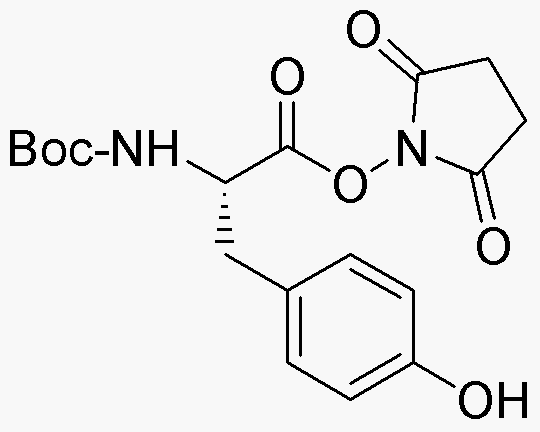Boc-L-tyrosine N-hydroxysuccinimide ester is widely utilized in research focused on:
- Peptide Synthesis: This compound serves as a key building block in the synthesis of peptides, allowing researchers to create complex structures with specific functionalities, enhancing the development of therapeutic agents.
- Drug Development: Its ability to modify amino acids makes it valuable in drug design, particularly in creating prodrugs that improve the bioavailability of active pharmaceutical ingredients.
- Bioconjugation: The ester functionality facilitates the conjugation of biomolecules, which is crucial in developing targeted drug delivery systems and diagnostic tools in the biomedical field.
- Research in Neuroscience: As a derivative of tyrosine, it plays a role in studying neurotransmitter pathways, aiding in the understanding of various neurological conditions and potential treatments.
- Protein Engineering: It is used to introduce specific modifications in proteins, enhancing their stability and activity, which is essential for various applications in biotechnology and pharmaceuticals.
Informations générales
Propriétés
Sécurité et réglementation
Applications
Boc-L-tyrosine N-hydroxysuccinimide ester is widely utilized in research focused on:
- Peptide Synthesis: This compound serves as a key building block in the synthesis of peptides, allowing researchers to create complex structures with specific functionalities, enhancing the development of therapeutic agents.
- Drug Development: Its ability to modify amino acids makes it valuable in drug design, particularly in creating prodrugs that improve the bioavailability of active pharmaceutical ingredients.
- Bioconjugation: The ester functionality facilitates the conjugation of biomolecules, which is crucial in developing targeted drug delivery systems and diagnostic tools in the biomedical field.
- Research in Neuroscience: As a derivative of tyrosine, it plays a role in studying neurotransmitter pathways, aiding in the understanding of various neurological conditions and potential treatments.
- Protein Engineering: It is used to introduce specific modifications in proteins, enhancing their stability and activity, which is essential for various applications in biotechnology and pharmaceuticals.
Documents
Fiches de données de sécurité (FDS)
La FDS fournit des informations de sécurité complètes sur la manipulation, le stockage et l’élimination du produit.
Spécifications du produit (PS)
Le PS fournit une description complète des propriétés du produit, notamment sa composition chimique, son état physique, sa pureté et les exigences de stockage. Il détaille également les plages de qualité acceptables et les applications prévues du produit.
Certificats d'analyse (COA)
Recherchez des certificats d'analyse (COA) en saisissant le numéro de lot du produit. Les numéros de lot et de lot se trouvent sur l'étiquette d'un produit, après les mots « Lot » ou « Lot de fabrication ».
Numéro de catalogue
Numéro de lot/série
Certificats d'origine (COO)
Ce certificat d'exploitation confirme le pays dans lequel le produit a été fabriqué, et détaille également les matériaux et composants utilisés et s'il est issu de sources naturelles, synthétiques ou autres sources spécifiques. Ce certificat peut être requis pour les douanes, le commerce et la conformité réglementaire.
Numéro de catalogue
Numéro de lot/série
Fiches de données de sécurité (FDS)
La FDS fournit des informations de sécurité complètes sur la manipulation, le stockage et l’élimination du produit.
DownloadSpécifications du produit (PS)
Le PS fournit une description complète des propriétés du produit, notamment sa composition chimique, son état physique, sa pureté et les exigences de stockage. Il détaille également les plages de qualité acceptables et les applications prévues du produit.
DownloadCertificats d'analyse (COA)
Recherchez des certificats d'analyse (COA) en saisissant le numéro de lot du produit. Les numéros de lot et de lot se trouvent sur l'étiquette d'un produit, après les mots « Lot » ou « Lot de fabrication ».
Numéro de catalogue
Numéro de lot/série
Certificats d'origine (COO)
Ce certificat d'exploitation confirme le pays dans lequel le produit a été fabriqué, et détaille également les matériaux et composants utilisés et s'il est issu de sources naturelles, synthétiques ou autres sources spécifiques. Ce certificat peut être requis pour les douanes, le commerce et la conformité réglementaire.


